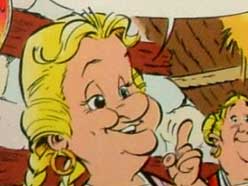| Title | Impedimenta |
| Category | Important Characters |
| Mangaka | nothing entered |
| Read Online | nothing entered |
First Appearance: Asterix and the Big Fight (but not named until Asterix and the Chieftain’s Shield)
Impedimenta is the matriarchal wife of Chief Vitalstatistix, leader of the village wives and the best cook in the village. She is often disappointed with the other villagers (calling them barbarians) and wishes Vitalstatistix was more ambitious. Consequently she zealously defends and flaunts every privilege due to her as first lady of the village, such as skipping the queue at the fishmongers. She frequently says she wants to go back to Lutetia and live with her successful merchant brother, Homeopathix – the one member of the family her husband openly dislikes.
She nicknamed Vitalstatistix “Piggywiggy” when they were courting, and starts doing this again in Asterix and the Soothsayer as a plan to make Asterix and Obelix erupt in hysterical laughter when she calls him by that name in front of them, thus irritating him and making him punish them by forcing them to stay in the village, away from the soothsayer.[4]
On occasion she has an antagonistic rivalry with Mrs. Geriatrix that has erupted into violence. One such occasion was in Asterix and the Magic Carpet where the two beat each other with fish from Unhygenix’s store over the fakir Watziznehm’s carpet.
Her name appears to derive directly from the Latin military term “impedimenta” – “baggage.”
- French: Bonemine (“bonne mine”, meaning “good looking”) – also used in Swedish or Esperanto, and in Greek Μπονεμίνα (Bonemina) or Μιμίνα (Mimina).
- In English, the name is derived from “impediment”, an obstacle, but possibly also a reference to the Latin ‘impedimenta,’ meaning ‘baggage’; (in the American translations: Belladonna – a poisonous plant used in cosmetics whose name means beautiful lady).
- In Italian, she is Beniamina.
- In Spanish, she is Karabella (meaning Beautiful face).
- In Portuguese, she is called Bonemine in some stories and Caralinda in others (Portuguese cara linda, “beautiful face”).
- In the Brazilian translation she is Naftalina.
- In Dutch, she is Bellefleur (Beautiful Flower in French).
- In German, she is Gutemine; Danish and Norwegian, Godemine, presumably from the old saying “Gute Miene zum bösen Spiel machen” (German), “At holde gode miner til slet spil” (Danish): “To keep up appearances in the face of bad deeds”), and mirroring the French “bonne mine”.
- In Hungarian, she is Hengerlice; which means ‘tumbler pigeon’, a pun on her being a little fat.
- In Turkish, she is Dediğimdediks. “Dediğim dedik” refers to someone who insists on getting their way.
- In Finnish, she is Smirgeline (a pun on the Finnish word smirgeli meaning “emery”, by way of the Finnish dysphemism for a “shrew” being a grinder)
- In Polish, she is Dobromina (most likely a pun on the Polish saying “robić dobrą minę do złej gry”, which has the same meaning as the German/Danish/Norwegian translation above, and the old Polish female given name Dobromira (‘the one that values goodness and peace’) or Dobromiła (‘the one that is good and nice’.)
- In Catalan, she is sometimes called Bonemina, but more usually Karabella.
- In Hindi, she is referred to as प्यारी सिरर्ददा ( Pyari Sirdarda), the beloved, who causes Headache.
- In Hebrew she is called זיופנים (Zivpanim), meaning “Bright face”.

